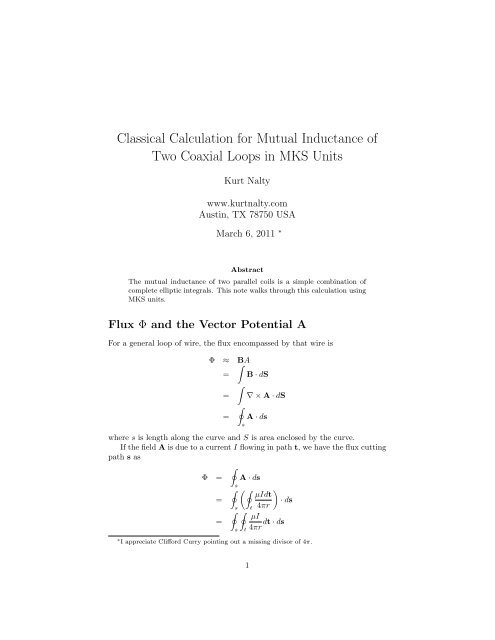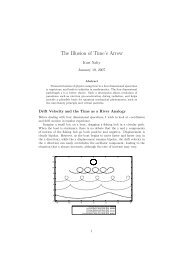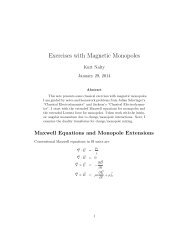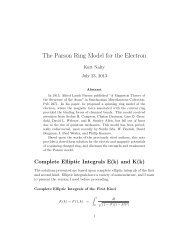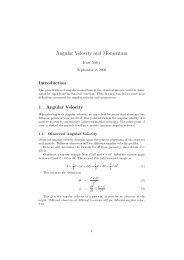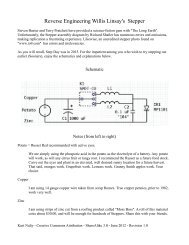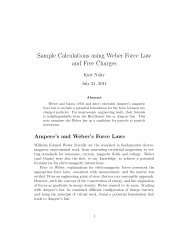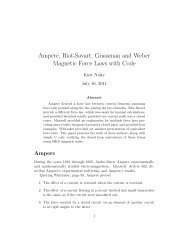Classical Calculation for Mutual Inductance of Two ... - Kurt Nalty
Classical Calculation for Mutual Inductance of Two ... - Kurt Nalty
Classical Calculation for Mutual Inductance of Two ... - Kurt Nalty
Create successful ePaper yourself
Turn your PDF publications into a flip-book with our unique Google optimized e-Paper software.
<strong>Classical</strong> <strong>Calculation</strong> <strong>for</strong> <strong>Mutual</strong> <strong>Inductance</strong> <strong>of</strong><br />
<strong>Two</strong> Coaxial Loops in MKS Units<br />
<strong>Kurt</strong> <strong>Nalty</strong><br />
www.kurtnalty.com<br />
Austin, TX 78750 USA<br />
March 6, 2011 ∗<br />
Abstract<br />
The mutual inductance <strong>of</strong> two parallel coils is a simple combination <strong>of</strong><br />
complete elliptic integrals. This note walks through this calculation using<br />
MKS units.<br />
Flux Φ and the Vector Potential A<br />
For a general loop <strong>of</strong> wire, the flux encompassed by that wire is<br />
Φ ≈ BA ∫<br />
= B · dS<br />
=<br />
∫<br />
∇ × A · dS<br />
∮<br />
= A · ds<br />
s<br />
where s is length along the curve and S is area enclosed by the curve.<br />
If the field A is due to a current I flowing in path t, we have the flux cutting<br />
path s as<br />
∮<br />
Φ = A · ds<br />
s<br />
∮ (∮ )<br />
µIdt<br />
=<br />
· ds<br />
s t 4πr<br />
∮ ∮<br />
µI<br />
=<br />
dt · ds<br />
4πr<br />
∗ I appreciate Clif<strong>for</strong>d Curry pointing out a missing divisor <strong>of</strong> 4π.<br />
s<br />
t<br />
1
<strong>Mutual</strong> <strong>Inductance</strong><br />
<strong>Mutual</strong> inductance and flux are related by Φ = MI. We thus have the Neumann<br />
<strong>for</strong>mula<br />
∮ ∮<br />
dt · ds<br />
M = µ<br />
s t 4πr<br />
For this exercise, separate the two coils along the z axis, at ±l/2. For<br />
generality, let the left green coil have radius L (<strong>for</strong> Left), and angle parameter<br />
φ, while the right orange coil has radius R (<strong>for</strong> Right) and angle parameter θ.<br />
We have<br />
ds = L (− sin φa x + cos φa y ) dφ<br />
dt = R (− sin θa x + cos θa y ) dθ<br />
ds · dt = LR (sin φ sin θ + cos φ cos θ) dφdθ<br />
= LR (cos (φ − θ)) dφdθ<br />
2
The positions and separations are<br />
r left = L cos φa x + L sin φa y − l 2 a z<br />
r right = R cos θa x + R sin θa y + l 2 a z<br />
∆r = (L cos φ − R cos θ) a x + (L sin φ − R sin θ) a y − la z<br />
r 2 = L 2 + R 2 + l 2 − 2LR (cos φ cos θ + sin φ sin θ)<br />
= L 2 + R 2 + l 2 − 2LR cos (φ − θ)<br />
r = √ L 2 + R 2 + l 2 − 2LR cos (φ − θ)<br />
We now can write our expression <strong>for</strong> the mutual inductance.<br />
∮ ∮<br />
dt · ds<br />
M = µ<br />
= µ ∮ ∮<br />
dt · ds<br />
s t 4πr 4π s t r<br />
= µ ∮ ∮<br />
4π<br />
= µ<br />
4π<br />
= µ<br />
4π<br />
∮<br />
φ<br />
θ<br />
( ∮<br />
φ θ<br />
∮<br />
φ<br />
( ∮<br />
θ<br />
LR (cos (φ − θ)) dφdθ<br />
√<br />
L2 + R 2 + l 2 − 2LR cos (φ − θ)<br />
)<br />
LR (cos (φ − θ)) dθ<br />
√ dφ<br />
L2 + R 2 + l 2 − 2LR cos (φ − θ)<br />
)<br />
LR (cos (θ − φ)) dθ<br />
√ dφ<br />
L2 + R 2 + l 2 − 2LR cos (θ − φ)<br />
where the last step uses the even nature <strong>of</strong> the cosine to absorb a minus sign.<br />
During the inner integration over θ, φ is kept constant. We now do a change<br />
<strong>of</strong> variable,<br />
γ = θ − φ<br />
dγ = dθ inside the θ integral<br />
We can simplify the mutual inductance expression.<br />
M = µ ∮ ( ∮<br />
4π φ γ<br />
= µ ∮<br />
4π<br />
= µ ∮<br />
2<br />
γ<br />
φ<br />
( ∮<br />
dφ<br />
γ<br />
LR cos γdγ<br />
√<br />
L2 + R 2 + l 2 − 2LR cos γ<br />
)<br />
dφ<br />
)<br />
LR cos γdγ<br />
√<br />
L2 + R 2 + l 2 − 2LR cos γ<br />
LR cos γdγ<br />
√<br />
L2 + R 2 + l 2 − 2LR cos γ<br />
This integral is known in terms <strong>of</strong> the complete elliptic functions K and E.<br />
The reference integral is<br />
∮<br />
cos θdθ<br />
√ = 4√ )<br />
]<br />
a + b<br />
[(1 − β2<br />
K(β) − E(β)<br />
a − b cos θ b<br />
2<br />
√<br />
2b<br />
where β =<br />
a + b<br />
3
We thus have<br />
a = L2 + R 2 + l 2<br />
L 2 R 2<br />
2<br />
b =<br />
√<br />
LR<br />
2b<br />
β =<br />
a + b<br />
√ )<br />
]<br />
a + b<br />
M = 2µ<br />
[(1 − β2<br />
K(β) − E(β)<br />
b 2<br />
Sample calculation with two 1 meter diameter coils, 1 meter apart.<br />
L = 0.5<br />
R = 0.5<br />
l = 1.0<br />
a = L2 + R 2 + l 2<br />
L 2 R 2 = 24<br />
2<br />
b =<br />
LR = 8<br />
√<br />
2b<br />
β =<br />
a + b = 0.7071<br />
µ = 4E − 7π<br />
K(0.7071) = 1.8541<br />
E(0.7071) = 1.3506<br />
M = 7.1041E − 8<br />
Comparison to Simple Integrator<br />
A comparison <strong>of</strong> closed <strong>for</strong>mula to numerically summed piecewise modelling<br />
follows.<br />
#include <br />
#include <br />
// calculated mutual inductance <strong>of</strong> two parallel coils,<br />
// 1 meter in diameter, 1 meter apart, 1 turn<br />
#define nseg 10<br />
#define pi 3.1415925<br />
4
typedef struct {<br />
double x;<br />
double y;<br />
double z;<br />
} vector;<br />
double dot(vector a, vector b)<br />
{<br />
return (a.x*b.x + a.y*b.y + a.z*b.z);<br />
}<br />
double mu_prime(vector sensor_coord, vector sensor_tangent)<br />
{<br />
double theta; // angle along path, cylindrical coordinates<br />
double dtheta; // differential angle along path<br />
double r=0.5; // radius <strong>of</strong> loop = 1 m diameter<br />
double z_source= 0.5; // position <strong>of</strong> source loop<br />
double z_sensor=-0.5; // position <strong>of</strong> sensor loop<br />
double s; // path length along coil<br />
double ds; // differential path length<br />
double mag_deltar; // difference between source and sensor<br />
double mu; // mu_prime<br />
double d_mu; // incremental mu_prime<br />
vector source_coord, source_tangent,deltar;<br />
int nturns = 1; // number <strong>of</strong> turns<br />
long i,j;<br />
s = 0.0;<br />
mu = 0.0;<br />
<strong>for</strong> (i=0; i
deltar.x = source_coord.x - sensor_coord.x;<br />
deltar.y = source_coord.y - sensor_coord.y;<br />
deltar.z = source_coord.z - sensor_coord.z;<br />
mag_deltar = sqrt(dot(deltar,deltar));<br />
d_mu = dot(source_tangent, sensor_tangent)/mag_deltar;<br />
mu += d_mu*ds;<br />
}<br />
return (mu);<br />
}<br />
double mu(void) // get mutual inductance<br />
{<br />
double theta; // angle along path, cylindrical coordinates<br />
double dtheta; // differential angle along path<br />
double r=0.5; // radius <strong>of</strong> loop = 1 m diameter<br />
double z_source= 0.5; // position <strong>of</strong> source loop<br />
double z_sensor=-0.5; // position <strong>of</strong> sensor loop<br />
double s; // path length along coil<br />
double ds; // differential path length<br />
double mag_deltar; // difference between source and sensor<br />
double mu; // mu_prime<br />
double d_mu; // incremental mu_prime<br />
vector source_coord, source_tangent,deltar;<br />
vector sensor_coord, sensor_tangent;<br />
int nturns = 1; // number <strong>of</strong> turns<br />
long i,j;<br />
s = 0.0;<br />
mu = 0.0;<br />
<strong>for</strong> (i=0; i
sensor_tangent.z = 0;<br />
printf("."); if((i%80) == 0) printf("\n"); // activity<br />
ds = r*dtheta;<br />
mu += ds*mu_prime(sensor_coord, sensor_tangent);<br />
s += ds;<br />
}<br />
printf("\ns = %g\n",s);<br />
mu *= 1.0e-7; // scale by mu_0/(4 pi)<br />
return (mu);<br />
}<br />
int main(void)<br />
{<br />
double M;<br />
M = mu();<br />
printf("M = %e\n\n",M);<br />
double L,R,l,a,b,beta,mu,K,E,M;<br />
L = 0.5;<br />
R = 0.5;<br />
l = 1.0;<br />
a = (L*L + R*R + l*l)/(L*L*R*R);<br />
b = 2.0/(L*R);<br />
beta = sqrt(2.0*b/(a+b));<br />
mu = 4.0e-7*pi;<br />
K = 1.8541;<br />
E = 1.3506;<br />
M = 2.0*mu*(sqrt(a+b)/b)*((1.0 - 0.5*beta*beta)*K - E);<br />
printf("a = %f\n",a);<br />
printf("b = %f\n",b);<br />
printf("beta = %f\n",beta);<br />
printf("M = %e\n\n",M);<br />
}<br />
/*<br />
Run time results<br />
.<br />
.........<br />
s = 3.14159<br />
7
M = 7.092998e-08<br />
a = 24.000000<br />
b = 8.000000<br />
beta = 0.707107<br />
M = 7.104169e-08<br />
Nice Agreement.<br />
*/<br />
8


